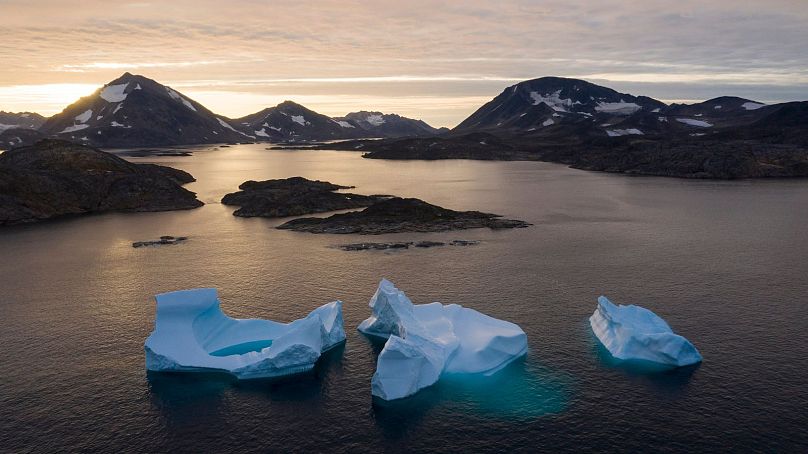The remote, ice-covered, and largely pristine Greenland plays a significant role in shaping the weather faced daily by billions of people and in the climate changes occurring on the planet.
According to Jeff Dabelko, a professor of security and ecology at Ohio University, Greenland is where "climate change, resource scarcity, tense geopolitics, and new trade schemes" intertwine.
Dabelko states that the world's largest island now "holds a central position in geopolitical and geo-economic competition in many ways," partly due to climate change.
Since taking office, elected President Donald Trump has expressed interest in acquiring Greenland, which is a self-governing territory of Denmark, a long-time ally of the U.S. and a founding member of NATO. It is also home to a significant U.S. military base.
Why is Greenland so desirable?
According to climatologist David Holland from New York University, Greenland acts as an open refrigerator door or thermostat for the warming planet, situated in a region that is heating up four times faster than the rest of the globe.
The depths of Greenland contain valuable rare earth minerals essential for telecommunications, as well as uranium, billions of untapped barrels of oil, and vast reserves of natural gas that are becoming increasingly accessible.
Many of these resources are currently supplied mainly to China, prompting interest from other countries, such as the United States, says Dabelko. Three years ago, the Danish government halted the development of oil fields in the sea in an area inhabited by 57,000 people.
But beyond oil, gas, or minerals, there is also ice—a "gigantic" amount, says climatologist Eric Rignot from the University of California, Irvine.

If the ice on the island melts, it will reshape coastlines around the world and potentially alter weather conditions so dramatically that this threat has even inspired a Hollywood disaster film.
Greenland has accumulated so much ice that if it all melts, global sea levels would rise by 7.4 meters. Approximately 30 centimeters of this is attributed to so-called zombie ice, which is already doomed to melt regardless of future conditions, according to a 2022 study.
Since 1992, Greenland has been losing about 182 billion tons (169 billion metric tons) of ice annually, with losses reaching 489 billion tons in 2019.
Mark Serreze, director of the National Snow and Ice Data Center in Boulder, Colorado, states that Greenland will be a "key point of focus" in the 21st century, as its melting ice sheet will impact sea levels. "In the future, it is likely to contribute increasingly."
According to Holland from New York University, this influence "may already be unstoppable."
Are other climate factors at play?
Greenland also serves as both a driver and a switch for a key ocean current that greatly influences the Earth's climate, including hurricane and winter storm activity. This current is known as the Atlantic Meridional Overturning Circulation, and it is slowing down because more freshwater is entering the ocean due to the melting ice in Greenland, says Serreze.
A slowdown or, worse, a collapse of this current would mark a turning point for the climate of Europe and parts of North America, which could plunge into prolonged freezes, as depicted in the 2004 film "The Day After Tomorrow."
"If this global current system were to slow significantly—as we know has happened in the past—normal temperature patterns and precipitation worldwide would change drastically," says climatologist Jennifer Francis from the Woodwell Climate Research Center.
Agriculture would be threatened, ecosystems would collapse, and "normal" weather would become a thing of the past.
According to Holland, Greenland is also changing color as it melts: from white ice, which reflects sunlight, heat, and energy, to the blue and green ocean and land that absorb much more energy.
Greenland plays a role in the sharp cooling currently experienced by two-thirds of the U.S. territory. According to winter weather expert Judah Cohen from the private company Atmospheric and Environmental Research, weather conditions over Greenland contributed to Superstorm Sandy’s path toward New York and New Jersey back in 2012.
Ice mountains above Greenland also alter the structure of the jet stream, which brings storms worldwide and dictates daily weather patterns. Often, especially in winter, a blocking high-pressure system off the coast of Greenland forces arctic air west and east, impacting North America and Europe, says Cohen.
Why is Greenland's location so important?
As most of Greenland lies above the Arctic Circle between the U.S., Russia, and Europe, it is a geopolitical prize that the U.S. and other countries have been eyeing for over 150 years. Its value increases as the Arctic becomes more accessible for shipping and trade.
But this does not take into account the unique appearance of the ice-covered island, which holds some of the oldest rocks on Earth.
"Greenland is incredibly beautiful. It’s just stunning," says Holland, who has conducted research on the ice more than 30 times since 2007.
"Chunks of ice the size of the Empire State Building just break off cliffs and crash into the ocean. And there’s also beautiful wildlife, seals, and orcas. It’s simply breathtaking."